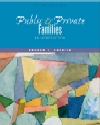EXERCISE 1 Although it's the most modern of media, the Internet is also a resource for historians. For instance, the Library of Congress maintains a site entitled, "American Life Histories: Manuscripts from the Federal Writers' Project, 1936-1940." During the Great Depression, the government employed over 300 writers to gather life histories from 2,900 people in 24 states. You can view these documents and search them by keywords such as marriage, divorce, and children (http://Lcweb2.loc.gov/wpaintro/wpahome.html). Enter "Haithcocks" in the search window to read a story of rural poverty among a family in Monkey Bottoms, a mill town in rural North Carolina. How had the Depression affected them? EXERCISE 2 The University of Rochester has placed on-line several monthly issues of Godey's Lady's Book from 1850, one of the most popular magazines of the nineteenth century. You can view articles, poems, and engravings (www.history.rochester.edu/godeys). Go to the February 1850 issue and read the story, "The Elopement," about a young woman whose father saves her from a tragic elopement at the last minute. What is the message to young women about obeying family versus their own hearts when choosing a husband? EXERCISE 3 The United States Department of Labor-Women's Bureau (http://www.dol.gov/dol/wb) compiles data on the status of women within the workforce. To obtain up-to-date information on the gaps in earnings between men and women, look for the heading Equal Pay and click on it. Next, click on Earnings Differences Between Women and Men. After reading the news release, answer the following questions: - What trends, if any, have occurred in women's earnings since the 1980's?
- What factors impact the earnings gap between men and women?
EXERCISE 4 The United States Census Bureau (http://www.census.gov) collects general statistical information about people and the economy through censuses and surveys. Click on search and type Black Population in the search box. Click on Black Population. Next, click on report under 1999 March CPS to obtain The Black Population in the United States: March 2000. After reading the news release, answer the following questions: - What percent of African American families were married couples in 1999?
- Of African American married couples, what percentage of families had three or more members? How does this compare to Non-Hispanic Whites?
EXERCISE 5 The Bureau of Indian Affairs (http://bialaw.fedworld.gov) is a department within the U.S. Department of the Interior that provides information on American Indians, Indian Tribes and Alaska Natives. Click on statistics under topics of interest. Next, click on click hereto connect to new location under statistics from the Department of the Interior and elsewhere to obtain statistics abstracts regarding Native Americans. Click on Tribal Reservation& Trustland Population under Indian statistics (pages copied from the statistical abstract). Click the magnifying glass (+) on the tool bar to enlarge the print if necessary. Examine the chart on page 51 and answer the following questions: - What two American Indian tribes have the largest population?
- What American Indian tribe has the largest percentage of married couples according to the percent distribution?
|



 2002 McGraw-Hill Higher Education
2002 McGraw-Hill Higher Education